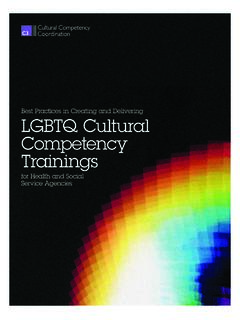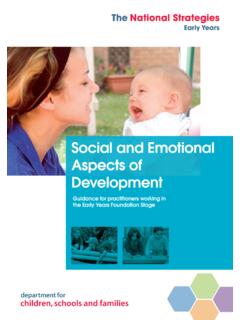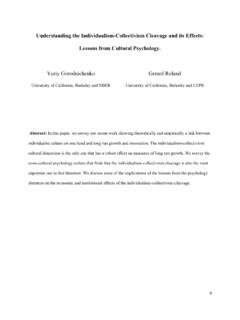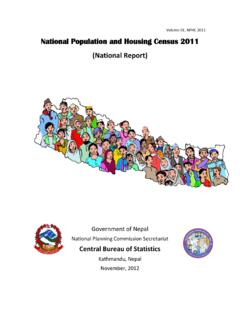Transcription of CHAPTER 2 The Sociology of Social Movements
1 CHAPTER 2 The Sociology of Social MovementsCHAPTER OBJECTIVES Explain the important role of Social Movements in addressing Social problems. Describe the different types of Social Movements . Identify the contrasting sociological explanations for the development and success of Social Movements . Outline the stages of development and decline of Social Movements . Explain how Social Movements can change 2505/02/19 10:10 AM26 \ CHAPTER 2 AFTER EARNING A BS IN COMPUTER ENGINEERING from Cairo University and an MBA in marketing and finance from the American University of Egypt, Wael Ghonim became head of marketing for Google Middle East and North Africa.
2 Although he had a career with Google, Ghonim s aspiration was to liberate his country from Hosni Mubarak s dictatorship and bring democracy to Egypt. Wael became a cyber activist and worked on prodemocracy websites. He created a Facebook page in 2010 called We are all Khaled Said, named after a young businessman who police dragged from an Internet caf and beat to death after Said exposed police corruption online. Through the posting of videos, photos, and news stories, the Facebook page rapidly became one of Egypt s most popular activist Social media outlets, with hundreds of thousands of followers (BBC 2011 , 2014; CBS News 2011 ).
3 An uprising in nearby Tunisia began in December 2010 and forced out its corrupt leader on January 14, 2011 . This inspired the thirty-year-old Ghonim to launch Egypt s own revolution. He requested through the Facebook page that all of his followers tell as many people as possible to stage protests for democracy and against tyranny, corruption, torture, and unemployment on January 25, 2011 . Hundreds of thousands turned out for the pro-tests in Cairo, Alexandria, and other cities, prompting the regime s security forces to seize Ghonim. On January 27, the government tried to stop the growing revolution by shutting down the Internet.
4 Google and many other organizations and individuals demanded Ghonim s release. He was set free after twelve days and emerged as a heroic symbol of the revolutionary struggle. For weeks the country was in turmoil as police tried to evict protestors from key areas of major cities, but popular momentum for change proved unstoppable. On February 9, hundreds of thousands of workers went on strike around the country, and on the 11th Mubarak was forced to resign, ending his thirty-year reign. Time magazine recognized Ghonim as one of the one hundred most influential persons of 2011 (Time 2013).
5 Later developments showed that although the events of January and February 2011 ended one dictatorship, they did not achieve democracy in Egypt. The revolution for democracy and Social jus-tice in that nation and others around the world continues, but Wael Ghonim s actions demonstrate how one courageous individual can play a key role in sparking a massive Social movement to address Social described in CHAPTER 1, the sociological imagination explains the role of Social forces in our lives. When people believe that Social forces cause a Social problem, they often organize a collective effort called a Social movement to do something about it.
6 This CHAPTER explores what Social Movements are, why and how they occur, and their stages of development, as well as their effectiveness in bringing about Social 2605/02/19 10:10 AMThe Sociology of Social Movements / 27 WHAT IS A Social MOVEMENT?As you learned in the last CHAPTER , a Social problem exists when there is widespread belief that a condition or pattern of behavior is harmful. A Social movement is a persistent and organized effort involving the mobilization of large numbers of people to work together to either bring about what they believe to be beneficial Social change or resist or reverse what they believe to be harmful Social change.
7 Social Movements are among the most dramatic events the world has ever known. The United States has experienced great Movements such as the abolitionist move-ment to end slavery in the nineteenth century, the women s suffrage movement to win the vote for women in the nineteenth and early twen-tieth centuries, and the civil rights movement in the 1950s and 1960s to end racial discrimination. Along with certain national election cam-paigns, Social Movements have become the most important collective force for bringing about change in the country s Movements can be classified in a number of ways.
8 One can first consider whether the movement intends to bring about or resist change. An innovative (liberal) movement intends to introduce something new with regard to culture, patterns of behavior, policies, or institutions. For example, a liberal movement exists to legalize mari-juana. A conservative movement has the goal of maintaining things the way they are (resisting change), such as the movement to prevent legalization of marijuana where it remains illegal. A reactionary move-ment seeks to resurrect cultural elements, patterns of behavior, or insti-tutions of the past ( bring back the good old days ).
9 An example would be a movement that wants to return to banning same-sex can also be classified in terms of which aspects of soci-ety are targeted for change. Is change sought in patterns of behavior, culture, policies, or institutions? Are the changes meant to affect every-one, or only a particular group of people? A reform movement calls for change in patterns of behavior, culture, and/or policy, but does not try to replace entire Social institutions. Supporters of reform Movements appeal to policymakers, attempt to elect candidates, and sometimes bring cases before courts to achieve their goals.
10 Movements involving civil rights, women s rights, sexual orientation, and the rights of people with disabilities all call for acceptance by the larger culture to ensure equal access to all Social institutions but do not aim to replace them. Antiwar and environmental Movements are also considered reform Movements because they call for changes in government policy rather than sweeping institutional revolutionary movement in contrast, aims to bring about great structural change by replacing one or more major Social institutions. In the eighteenth century, the American Revolution succeeded in changing the political system of the original thirteen colonies by freeing colonists from British monarchical control and creating a democratic form of government.







